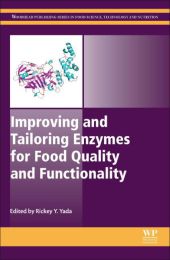 Neuerscheinungen 2015Stand: 2020-02-01 |
Schnellsuche
ISBN/Stichwort/Autor
|
Herderstraße 10
10625 Berlin
Tel.: 030 315 714 16
Fax 030 315 714 14
info@buchspektrum.de |

Rickey Yada
Improving and Tailoring Enzymes for Food Quality and Functionality
Ed. by Rickey Yada
2015. 266 p. 23 cm
Verlag/Jahr: WOODHEAD PUBLISHING 2015
ISBN: 1-78242-285-4 (1782422854)
Neue ISBN: 978-1-78242-285-3 (9781782422853)
Preis und Lieferzeit: Bitte klicken
Improving and Tailoring Enzymes for Food Quality and Functionality provides readers with the latest information on enzymes, a biological processing tool that offers the food industry a unique means to control and tailor specific food properties.
The book explores new techniques in the production, engineering, and application of enzymes, covering sourcing, isolation, and production of enzymes for food applications. In addition, chapters include detailed discussions of enzyme processing, analytical and diagnostic applications of enzymes in the food industry, and enzyme applications in specific food commodities.
Provides readers with the latest information on enzymes and their unique applications in the food industry
Explores new techniques in the production, engineering, and application of enzymes, covering sourcing, isolation, and production of enzymes for food applications
Chapters include detailed discussions of enzyme processing, engineering and analytical and diagnostic applications of enzymes in the food industry, and enzyme applications in specific food commodities
List of contributors
1: Introduction
1.1 Introduction
2: Factors affecting enzyme activity
Abstract
2.1 Fundamentals of thermodynamics
2.2 Formation of an enzyme-substrate complex
2.3 General principles of chemical kinetics
2.4 Enzymatic catalysis
2.5 Enzyme kinetics
2.6 Inhibition
2.7 Environmental considerations
2.8 An alternative view of enzyme catalysis
Part One: Separation, Preparation and Biosynthesis of Enzyme Sources
3: Traditional enzyme separation and preparation
Abstract
3.1 A brief history of enzymes
3.2 The sources
3.3 Enzyme preparation techniques: crude sample preparation
3.4 Enzyme preparation techniques: purification from crude preparations
3.5 Last words
4: Microbial biosynthesis of enzymes for food applications
Abstract
4.1 Introduction
4.2 Production of microbial enzymes for food applications
4.3 Intrinsic and extrinsic factors influencing the microbial biosynthesis of enzymes
4.4 Applications of microbial enzymes
4.5 Final remarks
Part Two: Enzyme Processing, Packaging, Analysis, and Valorization
5: Current and future uses of enzymes in food processing
Abstract
5.1 Introduction
5.2 Methods of producing enzymes
5.3 Biotechnological methods
5.4 Enzymes in food processing
5.5 Artificial enzymes
5.6 Concluding remarks
6: Enzymes for food waste remediation and valorisation
Abstract
6.1 Introduction
6.2 Food waste: sources and values
6.3 Bioremediation of wastewater
6.4 Waste valorisation
6.5 Perspectives and conclusions
7: Detection of pesticides in foods by enzymatic biosensors
Abstract
7.1 Introduction
7.2 Enzymatic biosensors for signal generation
7.3 Transducers for signal conversion
7.4 Parameters affecting biosensor performance
7.5 Conclusion
8: Enzymes for food-packaging applications
Abstract
8.1 Overview: basic concepts of packaging and shelf life
8.2 Active and intelligent packaging: key concepts
8.3 Carrier systems for enzymes
8.4 Enzyme-enabled active packaging
8.5 Enzyme-enabled intelligent packaging
8.6 Conclusion
Part Three: Applications of Enzymes in Foods
9: Enzymes in breadmaking
Abstract
9.1 Introduction
9.2 Plant-derived enzyme systems
9.3 Microbial and fungal enzymes
9.4 Future trends
9.5 Further information
10: Enzymes in meat and fish
Abstract
10.1 Introduction
10.2 Major classes of endogenous enzymes in muscle foods
10.3 Major enzymatic postmortem changes in muscle foods
10.4 Main roles of enzymes in the quality and safety of meat and fish
10.5 Enzymes involved in restructured meat and fish
10.6 Effects of processing on enzyme activity
11: Enzyme engineering (immobilization) for food applications
Abstract
11.1 Introduction
11.2 Immobilization technologies
11.3 Reactive groups and immobilization carriers
11.4 Applications and scope of enzyme immobilization
11.5 Recent advances and emerging trends in enzyme immobilization
11.6 Conclusions
Index


